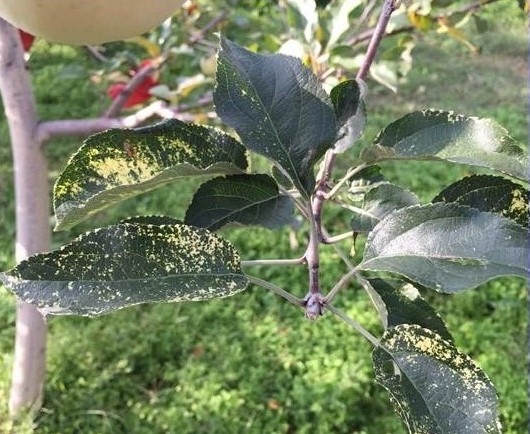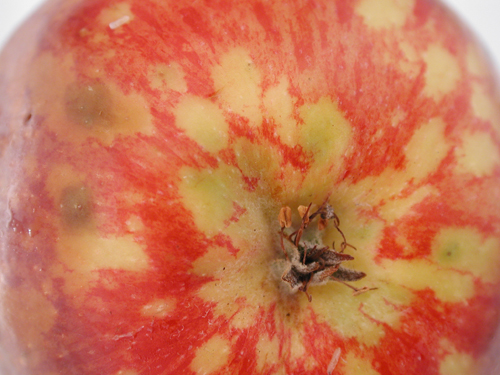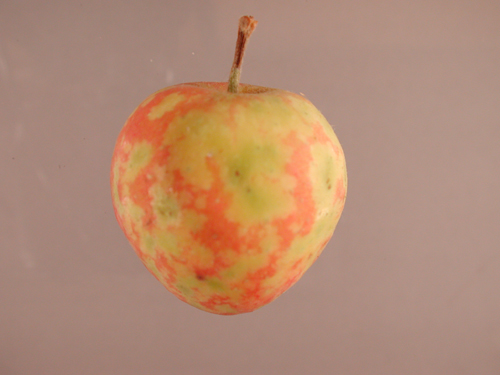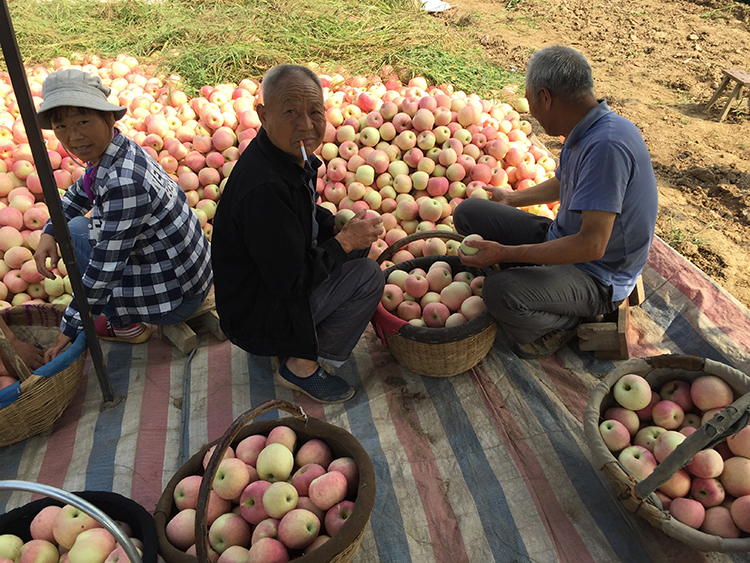CAST OF CHARACTERS
Fuwang Li: A typical commercial apple grower in Yangling, Shaanxi Province, China
Xilai Zhang: Fuwang Li 's neighbor, whose apple trees are devastated by apple scar skin viroid
Han Qi: Plant pathologist at Northwest A&F University, Yangling
THE CASE
Fuwang Li and his family live in Yangling, Shaanxi Province, China. His livelihood depends on his own 6-mu (equals 1-acre or 0.4-hectare) apple orchard. He bought and planted apple trees three years ago. Before planting his trees, he had grafted them himself, by joining the scion or above-ground portion of the tree (cultivar Fuji) to a suitable rootstock. He pruned them at the proper time and fertilized according to recommendations for his region of Shaanxi Province. Everyone in his village admired his industriousness and thought he would earn a good profit from his fruit.
Figure 1: Circular, yellow dappling
showing on apple
|

Figure 2: Prof. Qi (with hat) visits Fuwang's orchard
|
Last week, he heard that his neighbor Xilai Zhang's apple orchard experienced an outbreak of a disease problem that nobody in the area had ever seen before. Many of Xilai Zhang's apples had circular, yellow dappling on them (Figure 1). As a result, no one would buy these apples, so he had nothing to sell. Xilai Zhang was very upset and hopeless.
Fuwang was deeply worried by the disaster that had befallen his neighbor's apples. What if Xilai Zhang's disaster spread to his own orchard? He listened carefully to Xilai's description of the problems he'd seen on his apples. At first, Xilai's apples showed small circular shown up on the fruit. Then the spots became larger and larger. Xilai used fungicide sprays in an attempt to control the spots, but in vain: The circular patches expanded, making the fruit unsaleable, even after Xilai had sprayed with several kinds of fungicides. Xilai had no idea why fungicides have had no effect.
After talking with Xilai yesterday, Fuwang realized that his own orchard was strikingly similar in several ways. For one thing, Fuwang and Xilai had bought apple scions for grafting from the same supplier. This made him feel a little anxious. Fuwang walked through his own orchard immediately. Unfortunately, he saw some spots on apples that looked like the ones in Xilai's orchard. His worry deepened: was he facing the loss of his orchard?
Fuwang couldn't sleep. His hope to raise the money to send his two sons to an excellent high school and university was starting to fade. He couldn't stop worrying about his endangered orchard and the threat to his livelihood and his plans to educate his sons.
The next morning, he took the long-distance bus to Northwest A&F University in Yangling, looking for help. He was directed to Dr. Han Qi, who is a plant pathology professor specializing in apple diseases.
After hearing Fuwang's story, Professor Qi was also worried. He visited Fuwang's orchard to check the disease, and also walked through Xilai's adjacent orchard (Figure 2). He talked to both growers about their grafting practices. Then he gave them the bad news: “I think Xilai's apple trees have been infected by a viroid, which is a very tiny parasite that is related to a virus. I'll have to confirm my suspicions about the involvement of the viroid with some laboratory tests of the apples and leaves, but I'm fairly sure that's what we are seeing. The viroid may have originated from infected stock plants – either the scion or the rootstock."
“It's likely that the viroid was spread from this contaminated source during the grafting process for both your and Xilai's orchards, because it can contaminate the tools that you used to make the grafts and then invade the trees through the grafting wounds. Spreading the viroid from tree to tree during grafting may mean that many of your grafted trees were already infected when they were planted in your orchard. So two things probably went wrong: a source of your grafted scions or rootstocks was contaminated to start with, then the viroid spread during the wounding that is needed to make the grafts."
“Unfortunately, we have no way of curing a tree once it's been infected with a viroid. The apples will show symptoms year after year, and the health of the infected trees will gradually decline to the point that they cannot produce a commercial crop of fruit."
This diagnosis was even worse than Fuwang had feared. Was there no way to control it after the grafting was done? The diagnosis was much too late to help Fuwang. It puzzled him that during its earlier years, his orchard had appeared completely healthy. Professor Qi told him, “Apple scar skin viroid (ASSVd) can stay hidden inside the trees for years, gradually building up their concentration in the trees but showing no symptoms. This is called the incubation period. You know apple trees need around two years to grow before fruit develop, then when the tree begins to bear fruit around the third year, the stress created by the developing fruit can trigger an outbreak of symptoms."
Fuwang was despondent. “What? I spent almost my whole savings on my orchard. Now the first year I should have apples to sell, I can't sell them. How will I pay my sons' tuition?" “I understand how distressed you feel. But I think I can help you to figure out a way to deal with your problem," Professor Qi consoled Fuwang. In his office, Qi explained more details to Fuwang.
“The full name for this disease is Apple scar skin Viroid (ASSVd). It is one of the most serious viral diseases on apple, and it has been reported from apple orchards in China for almost 70 years. This disease affects apple and pear. The cultivar Red Fuji, which you planted, has been very widely planted in Shaanxi Province in recent decades, and is highly susceptible to this viroid. “
Professor Qi continued, “this may be the key part of the story for your orchard: transmission of the viroid." ASSVd on apple is transmitted mainly by grafting or pruning, when contaminated tools spread the viroid during the tissue wounding that accompanies these activities. Whether insects can transmit ASSVd is uncertain; however, the main method of spread appears to be grafting. Fuwang may have had just a few scions or rootstocks with ASSVd contamination to start with, but the grafting process can dramatically increase the number of infected trees that are planted in an orchard.
Once trees are infected by the viroid, many cultivars don't show symptoms right away. When symptoms showed up, fruit show small spots on the surface (Figure 3), and yellow mottling also appears on leaves (Figure 4). As the fruit mature, the spots enlarge and cause yellowish rings on the fruit surface. Some even transition from yellow to brown (Figure 5). Some fruit are also abnormally small and misshapen (Figure 6). It frequently results in large economic losses." "What should I do? What can I do?" Fuwang said desperately. In reply, Professor Qi offered some ideas to help Fuwang devise a strategy to cope with this viroid crisis.
 Figure 3: Spots show on 'Red Fuji' fruit surface
Figure 3: Spots show on 'Red Fuji' fruit surface |

Figure 4: Yellow mottling appears
on leaves |

Figure 5: Yellow patches that turn brownish with age (Reprinted, by permission, from Dr. Melodie Putnam, Oregon State University)
|

Figure 6: Some fruit are abnormally small
(Reprinted, by permission, from Dr. Melodie Putnam, Oregon State University)
|
QUESTIONS
- What are the symptoms of Apple scar skin viroid (ASSVd)?
- Why did Fuwang's orchard appear completely healthy during its earlier years, before the trees started to bear fruit?
- What are the main ways in which Apple scar skin viroid is transmitted?
DISEASE MANAGEMENT
Virus-and viroid-free certified planting material
The most effective methods to combat plant viral diseases are aimed at prevention. In the present case, that means doing everything possible to keep ASSVd out of the orchard. There is no cure for diseases caused by viruses or viroids once they have infected a host plant. As a result, using virus-free and viroid-free planting materials is the most effective way to prevent these diseases from spreading long distances. How can such a “clean-plant" movement get started? Many countries, in collaboration with commercial tree producers, have adopted practices that require or recommend purchasing only planting stock that has been reliably certified to be free of viruses and viroids. The planting stock is tested repeatedly for presence of known viruses and viroids; material that tests positive at any stage or production is discarded and destroyed. Unfortunately, Fuwang's region of Shaanxi Province doesn't yet have a certified clean plant network. In addition, many countries have instituted strict quarantine programs, in which imported plants are inspected, and their certifications are checked, to prevent entry of infected plants into these countries. Planting viroid-free trees is a major step toward minimizing the risk of ASSVd.
Cultural practices
Grafting means combining the scion (upper part of the combined plant) and the rootstock (lower part) – into a single plant. The idea behind grafting is to get “the best of both worlds" by combining rootstocks that produce trees of a desired size with scions that yield abundant fruit of varieties that the market prefers. However, the wounds caused by grafting cuts can introduce viroids and viruses into plant cells. Therefore, disinfecting grafting tools frequently when making grafting cuts is a way to prevent viroid and virus transmission from infected tissues to healthy tissues.
Almost all commercial apple trees are pruned – that is, selected shoots and branches are removed - annually in order to control tree size and allow light to penetrate throughout the tree canopy, which optimizes fruit quality. Growers can use disinfectant to clean pruning materials; for example, dipping pruning tools in 2% sodium hypochlorite (chlorine bleach) solution, can prevent viroid and virus transmission. During pruning in an orchard with some viroid-infected trees, it is advisable to prune the healthy-looking trees first, then the ones with symptoms, in order to minimize the risk of spreading the viroid from infected trees to healthy trees. An alternative approach is to remove ASSVd-infected trees in orchards as soon as it becomes clear that they are infected, to avoid possible spread of the viroid to neighboring trees by means of pruning wounds.
Insecticide sprays
The significance of insects in transmitting apple scar skin viroid in apple orchards has not been determined. However, there is evidence that ASSVd can be transmitted by the greenhouse whitefly (
Trialeurodes vaporariorum) to plants such as bean and cucumber under experimental conditions. As a result, spraying insecticides could be considered a precautionary strategy given the uncertainty about the risk of ASSVd transmission by pest insects, but this practice also would impose an added expense for apple producers.
Background
Apple industry in China
Almost half of the world's apples are produced in China, and Shaanxi Province alone includes more than 20% of total Chinese apple production. Typical commercial apple orchards in China are small in scale - less than 0.4 hectares in size – but the number of growers is large: approximately 10 million. When it comes to harvest season, neighbors gather together to help each other pick apples (Figure 7 and 8).
Different ASSVd symptoms on different apple cultivars
Symptoms of ASSVd vary among different apple cultivars. ASSVd spots on fruit may coalesce (grow together) to form patterns of yellow dappling on 'Red Fuji' fruit (Figure 3), whereas 'Golden Delicious' will show brown, circular areas (Figure 9).
Viruses and viroids that attack plants
Viruses are tiny pathogenic (disease-causing) particles that can be seen only with an electron microscope. Plant cells have cell structure like cell walls, cell membrane and nucleus. But viruses lack cell structure and must parasitize cells of a host organism in order to survive. Viruses are much smaller than bacteria, and exist as particles of nucleic acid (DNA or RNA) encased within a protein shell. Viroids are even smaller than most viruses; they consist of tiny single-stranded molecules of ribonucleic acid (RNA), and lack an outer layer of protein. In perennial (multi-year) cropping systems like apples, viroids can spread rapidly by means of contaminated pruning and grafting tools, farm implements, clothing, or human hands.
After viroids are inoculated onto a new host, they will attack and invade the cells. Once viroids get into host cells, they interrupt normal functioning by hijacking the cells' biochemical machinery to further their own growth and reproduction. After new copies of viroids form, they can break out of host cells and infect nearby cells.


Figure 7 and 8: Apple harvest in a village located in Shaanxi Province, China
|

Figure 9: Symptoms of ASSVd
on ‘Golden Delicious’
|
Certification systems for disease-free planting material
In many countries, scientists, educators, state and federal regulators, large and small nurseries, and growers collaborate in networks whose objective is to make sure that the country's perennial plants are free of known diseases when they are produced and sold. So-called clean plant networks have been developed to ensure that plant propagation material is pathogen-free and available. Trained staff conduct regular visual inspections and laboratory testing to provide this assurance. For example, apple growers can purchase young trees that are certified to be free from viruses and viroids. Adoption of clean plant networks by growers has greatly reduced the risk of diseases such as apple scar skin viroid in many countries – provided that all growers participate in the system. Although instituting clean plant networks in apple production would sharply increase the cost of young apple trees, they have the potential to eliminate virus and viroid diseases as serious economic risks. For more information on one example of a clean plant network, visit:
http://nationalcleanplantnetwork.org
Apple grafting and pruning
Grafting apples is a standard practice in apple production worldwide. It can combine desirable qualities of two plants - the scion (upper part of the combined plant) and the rootstock (lower part) – into a single plant. For example, a goal for apple grafting would be to combine large, flavorful, commercially popular fruit (scion) with small tree size (rootstock). Grafting requires making cuts into both the scion and rootstock to create a zone where the two segments can grow together. Figure 10 shows two scions inserted into a cleft in the rootstock.
Pruning (Figure 11) means cutting off branches or shoots in order to keep trees from becoming overcrowded and to make sure that fruit in the lower part of the tree canopy receive enough light to develop optimally. Generally, apple growers prune their trees in late winter, but summer pruning is recommended in some circumstances.

Figure 10: Grafting (Reprinted, by permission, from
Dr. Wesley Autio, University of Massachusetts Amherst)
| 
Figure 11: Pruning
|
DISCUSSION
- The area doesn't have certified clean plant network. If Fuwang is offered “clean plants" from an unknown provider, should he buy it? Why?
- If you were Fuwang, what strategies would you employ to slow the spread of ASSVd in the following scenario: one row of your apple trees has fruit that show symptoms of apple scar skin viroid, but fruit in the other 4 rows of the orchard appear healthy?
- If you were Fuwang, should you spray insecticides on your orchard to reduce the risk of ASSVd transmission by pest insects, or do something else? Why?
- Imagine that you, in Fuwang's situation, are considering whether to plant a new orchard next to your orchard that shows symptoms of ASSVd. What management practices should you implement in order to minimize the risk of ASSVd infection in this new orchard?
Acknowledgements
We thank Dr. Nicholas T. Peters (Iowa State University) for providing access to his PLP 408 class (Principles of Plant Pathology) for the in-class discussion, and the students in PLP 408 class for providing feedback on this case study.
References
- Ahmed Hadidi, MarinaBarba, NiHong, VipinHallan. 2017. Viroids and Satellites, chapter 21:217-228.
https://doi.org/10.1016/B978-0-12-801498-1.00021-8
- Hadidi, A., Barba, M., Candresse, T., and Jelkmann, W. 2011. Virus and Virus-like Diseases of Pome and Stone Fruits. St. Paul, MN: APS Press.
- Kim, H.R, Lee, S.H, Lee, D.H, Kim, J.S and Park, J.W. 2006. Transmission of Apple scar skin viroid by Grafting, Using Contaminated Pruning Equipment, and Planting Infected Seeds. The Plant Pathology Journal, 22(1): 63–67.
https://doi.org/10.5423/PPJ.2006.22.1.063
- Stephen A.H, David A.R, George L. 2006. The Apple Industry in China. NEW YORK FRUIT QUARTERLY. Vol.14: 13-20.
- Wang, Y.N, Hu, T.L, Liu, S.X, Zhao X.S, Yang J.Y, Cao K.Q.2010. Research Status of Apple Virus Disease in China. Journal of Anhui Agricultural Sciences,38(15):7933-7936
- Yashika W, Sunny D, Aijaz Asghar Z, Vipin H.2015. Apple scar skin viroid naked RNA is actively transmitted by the whitefly Trialeurodes vaporariorum. RNA Biology, 12(10): 1131–1138
-
https://pnwhandbooks.org/plantdisease/host-disease/apple-malus-spp-scar-skin-dapple-apple
-
http://treefruit.wsu.edu/crop-protection/disease-management/
-
https://www.thoughtco.com/plant-viruses-373892
-
https://garden.org/learn/articles/view/767/
-
https://ohioline.osu.edu/factsheet/plpath-gen-5
